Di-tert-butyl disulfide
Synonym(s):tert-Butyl disulfide;Di-tert-butyl disulfide;tert-Butyl disulfide
- CAS NO.:110-06-5
- Empirical Formula: C8H18S2
- Molecular Weight: 178.36
- MDL number: MFCD00008838
- EINECS: 203-734-1
- SAFETY DATA SHEET (SDS)
- Update Date: 2024-12-18 14:15:30
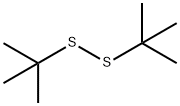
What is Di-tert-butyl disulfide?
Chemical properties
clear pale yellow to yellow liquid
The Uses of Di-tert-butyl disulfide
Di-tert-butyl disulfide is used in the preparation of gold-supported thin film from symmetrical and mixed disulphide adsorbates.
Mechanism of the oxidation of di-tert-butyl disulfide in the presence of H2O2 catalyzed by bis(acetylacetonato)oxovanadium and a chiral Schiff-base ligand has been investigated.
Di-tert-butyl disulfide has been used in the preparation of gold-supported thin film from symmetrical and mixed disulphide adsorbates.
The Uses of Di-tert-butyl disulfide
Di-tert-Butyl Disulfide is a general reagent used in the synthesis of a novel neuropeptide Y (NPY) Y5 receptor antagonist Velneperit) used in the treatment of obesity.
What are the applications of Application
Di-tert-butyl disulfide is used in the preparation of gold-supported thin film from symmetrical and mixed disulphide adsorbates
Synthesis Reference(s)
Synthetic Communications, 13, p. 611, 1983 DOI: 10.1080/00397918308059536
Synthesis, p. 669, 1978 DOI: 10.1055/s-1978-24844
Tetrahedron Letters, 31, p. 3591, 1990 DOI: 10.1016/S0040-4039(00)94450-2
General Description
Mechanism of the oxidation of di-tert-butyl disulfide in the presence of H2O2 catalyzed by bis(acetylacetonato)oxovanadium and a chiral Schiff-base ligand has been investigated.
Properties of Di-tert-butyl disulfide
| Melting point: | -5 °C |
| Boiling point: | 200-201 °C(lit.) |
| Density | 0.923 g/mL at 25 °C(lit.) |
| vapor density | 5 (vs air) |
| vapor pressure | 51.7 mm Hg ( 37.7 °C) |
| refractive index | n |
| Flash point: | 144 °F |
| storage temp. | Inert atmosphere,Room Temperature |
| solubility | Chloroform (Sparingly), Ethanol (Slightly) |
| form | Liquid |
| color | Clear pale yellow to yellow |
| Odor Threshold | 0.0018ppm |
| explosive limit | 0.8%(V) |
| BRN | 1698170 |
| CAS DataBase Reference | 110-06-5(CAS DataBase Reference) |
| EPA Substance Registry System | Disulfide, bis(1,1-dimethylethyl) (110-06-5) |
Safety information for Di-tert-butyl disulfide
| Signal word | Warning |
| Pictogram(s) |
 Environment GHS09 |
| GHS Hazard Statements |
H411:Hazardous to the aquatic environment, long-term hazard |
| Precautionary Statement Codes |
P273:Avoid release to the environment. P391:Collect spillage. Hazardous to the aquatic environment P501:Dispose of contents/container to..… |
Computed Descriptors for Di-tert-butyl disulfide
| InChIKey | BKCNDTDWDGQHSD-UHFFFAOYSA-N |
New Products
Tert-butyl bis(2-chloroethyl)carbamate (S)-3-Aminobutanenitrile hydrochloride N-Boc-D-alaninol N-BOC-D/L-ALANINOL N-octanoyl benzotriazole 4-Hydrazinobenzoic acid 3,4-Dibenzyloxybenzaldehyde 1,1’-CARBONYLDIIMIDAZOLE R-2-BENZYLOXY PROPIONIC ACID 1,1’-CARBONYLDI (1,2-4 TRIAZOLE) 4-HYDROXY BENZYL ALCOHOL 3-NITRO-2-METHYL ANILINE (2-Hydroxyphenyl)acetonitrile 4-Bromopyrazole 5-BROMO-2CYANO PYRIDINE 5,6-Dimethoxyindanone 5-broMo-2-chloro-N-cyclopentylpyriMidin-4-aMine 4-methoxy-3,5-dinitropyridine 2-(Cyanocyclohexyl)acetic acid 2-aminopropyl benzoate hydrochloride 1-(4-(aminomethyl)benzyl)urea hydrochloride tert-butyl 4- (ureidomethyl)benzylcarbamate diethyl 2-(2-((tertbutoxycarbonyl)amino) ethyl)malonate Ethyl-2-chloro((4-methoxyphenyl)hydrazono)acetateRelated products of tetrahydrofuran

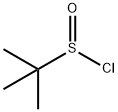
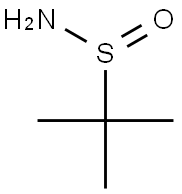

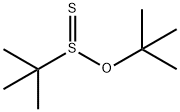


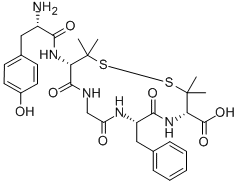
You may like
-
 Di-tert-butyl Disulfide CAS 110-06-5View Details
Di-tert-butyl Disulfide CAS 110-06-5View Details
110-06-5 -
 Di-tert-butyl disulfide 95% CAS 110-06-5View Details
Di-tert-butyl disulfide 95% CAS 110-06-5View Details
110-06-5 -
 Di-tert-butyl disulfide CAS 110-06-5View Details
Di-tert-butyl disulfide CAS 110-06-5View Details
110-06-5 -
 Di-tert-butyl disulfide CAS 110-06-5View Details
Di-tert-butyl disulfide CAS 110-06-5View Details
110-06-5 -
 N-Vinylformamide 99%View Details
N-Vinylformamide 99%View Details
13162-05-5 -
 Chloro Uracil 1820-81-1 99%View Details
Chloro Uracil 1820-81-1 99%View Details
1820-81-1 -
 2-ethyl-6-methyl-3-hydroxypyridine succinate 99%View Details
2-ethyl-6-methyl-3-hydroxypyridine succinate 99%View Details
127464-43-1 -
 2-ETHYLPYRIDINE 100-71-0 99%View Details
2-ETHYLPYRIDINE 100-71-0 99%View Details
100-71-0